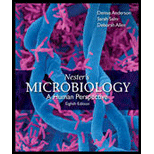
Concept explainers
Describe three types of symbiotic relationships.
To review:
The types of symbiotic relationships.
Introduction:
Symbiosis or symbiotic relationship is a short or long-term biological interaction between different kinds of organisms. It can be obligatory or facultative. In obligatory relationships, one or both the organisms are completely dependent on each other, whereas in facultative symbiosis, the two organisms are partially dependent on each other and can generally live independently also. The organisms interacting in symbiotic relationships are known as symbionts.
Explanation of Solution
Symbiosis is the type of interaction in which the two or more organism are dependent on each other completely or partially and either beneficial or harmful for each other. Symbiotic relationships are of mainly threetypes: mutualism, commensalism, and parasitism.
Mutualism: It is a symbiotic association between the two organisms that are beneficial to each other, it is mostly a long-term association. The symbionts mainly belong to the different species of organisms. For example, the microflora living in the gut of humans are in a mutualistic relationship with the humans. Bacteria synthesize vitamins, which are required by the human host and bacteria takes nourishment from the gut of the humans, therefore, benefiting each other.
Commensalism: It is a relationship between two organisms where one is benefitted by the other, while the other one is neither benefitted nor harmed. For example, many bacteria living on the human skin are neither helpful nor harmful for them, but they derive food and nutrition from the humans thus, are benefiting.
Parasitism: It is a relationship in which one organism is benefitted while the other is harmed. The organism that gets the benefit is known as a parasiteatthe expense of the other organism known as the host. Parasites are of two types, endoparasites that live inside the body of the host, and ectoparasites that live on the body surface of the host.
Therefore, the three main types of symbiotic relationships are mutualism, commensalism, and parasitism that are defined on the basis of their beneficiary or harmful interaction between the organisms involved.
Want to see more full solutions like this?
Chapter 16 Solutions
Nester's Microbiology: A Human Perspective
- What did the Cre-lox system used in the Kikuchi et al. 2010 heart regeneration experiment allow researchers to investigate? What was the purpose of the cmlc2 promoter? What is CreER and why was it used in this experiment? If constitutively active Cre was driven by the cmlc2 promoter, rather than an inducible CreER system, what color would you expect new cardiomyocytes in the regenerated area to be no matter what? Why?arrow_forwardWhat kind of organ size regulation is occurring when you graft multiple organs into a mouse and the graft weight stays the same?arrow_forwardWhat is the concept "calories consumed must equal calories burned" in regrads to nutrition?arrow_forward
- You intend to insert patched dominant negative DNA into the left half of the neural tube of a chick. 1) Which side of the neural tube would you put the positive electrode to ensure that the DNA ends up on the left side? 2) What would be the internal (within the embryo) control for this experiment? 3) How can you be sure that the electroporation method itself is not impacting the embryo? 4) What would you do to ensure that the electroporation is working? How can you tell?arrow_forwardDescribe a method to document the diffusion path and gradient of Sonic Hedgehog through the chicken embryo. If modifying the protein, what is one thing you have to consider in regards to maintaining the protein’s function?arrow_forwardThe following table is from Kumar et. al. Highly Selective Dopamine D3 Receptor (DR) Antagonists and Partial Agonists Based on Eticlopride and the D3R Crystal Structure: New Leads for Opioid Dependence Treatment. J. Med Chem 2016.arrow_forward
- The following figure is from Caterina et al. The capsaicin receptor: a heat activated ion channel in the pain pathway. Nature, 1997. Black boxes indicate capsaicin, white circles indicate resinferatoxin. You are a chef in a fancy new science-themed restaurant. You have a recipe that calls for 1 teaspoon of resinferatoxin, but you feel uncomfortable serving foods with "toxins" in them. How much capsaicin could you substitute instead?arrow_forwardWhat protein is necessary for packaging acetylcholine into synaptic vesicles?arrow_forward1. Match each vocabulary term to its best descriptor A. affinity B. efficacy C. inert D. mimic E. how drugs move through body F. how drugs bind Kd Bmax Agonist Antagonist Pharmacokinetics Pharmacodynamicsarrow_forward
 Comprehensive Medical Assisting: Administrative a...NursingISBN:9781305964792Author:Wilburta Q. Lindh, Carol D. Tamparo, Barbara M. Dahl, Julie Morris, Cindy CorreaPublisher:Cengage Learning
Comprehensive Medical Assisting: Administrative a...NursingISBN:9781305964792Author:Wilburta Q. Lindh, Carol D. Tamparo, Barbara M. Dahl, Julie Morris, Cindy CorreaPublisher:Cengage Learning Biology 2eBiologyISBN:9781947172517Author:Matthew Douglas, Jung Choi, Mary Ann ClarkPublisher:OpenStax
Biology 2eBiologyISBN:9781947172517Author:Matthew Douglas, Jung Choi, Mary Ann ClarkPublisher:OpenStax- Basic Clinical Lab Competencies for Respiratory C...NursingISBN:9781285244662Author:WhitePublisher:Cengage
 Concepts of BiologyBiologyISBN:9781938168116Author:Samantha Fowler, Rebecca Roush, James WisePublisher:OpenStax College
Concepts of BiologyBiologyISBN:9781938168116Author:Samantha Fowler, Rebecca Roush, James WisePublisher:OpenStax College





